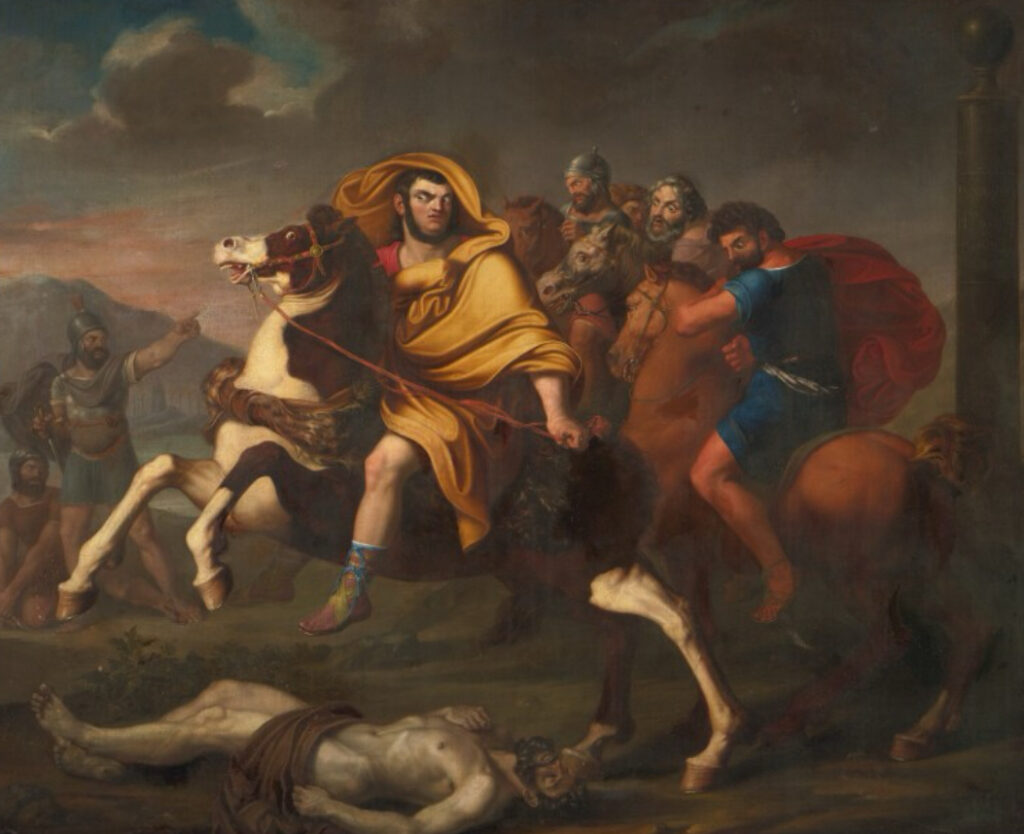The painting “Emperor Nero Fleeing With His Entourage,” attributed to an 18th-century French artist, captures one of the most dramatic moments in Roman history—Nero’s flight from Rome in the wake of its decline. This depiction of Nero, the infamous Roman emperor known for his excesses, cruelty, and cultural ambitions, evokes a sense of both impending doom and desperate survival. As an oil-on-canvas masterpiece, the artwork becomes more than a mere historical scene; it becomes a symbol of the corrupting influence of power, the fallibility of rulers, and the fragile nature of empires.
The Historical Context: Nero and the Fall of Rome
Before diving into the painting’s narrative and composition, it is crucial to establish the historical background against which the artist creates this dramatic scene. Nero, who reigned as emperor from 54 to 68 AD, was a deeply controversial figure in Roman history. He is perhaps best known for the Great Fire of Rome in AD 64, an event that ravaged the city and left thousands homeless. While rumors circulated that Nero himself started the fire to clear space for his lavish Domus Aurea (Golden House), historians today debate this claim. Nonetheless, Nero’s handling of the crisis—his apathy, his focus on personal luxury, and his brutal scapegoating of Christians—cemented his reputation as a tyrant.
In AD 68, facing military revolts, political conspiracies, and the rising animosity of the Roman Senate, Nero’s grip on power began to unravel. His own Praetorian Guard, once his fiercest protectors, abandoned him. His final act of desperation was his flight from Rome, where he sought refuge with a former slave and prepared for what he knew would be the end—either his forced surrender or his suicide.
The painting’s title, “Emperor Nero Fleeing With His Entourage,” immediately places us at this pivotal moment in history: the final hours of an emperor who had once seemed untouchable but was now reduced to a fugitive. The artist’s choice to focus on this specific moment reflects a fascination with Nero’s downfall and the ultimate vulnerability of even the most powerful leaders.
The Composition: Chaos and Desperation in Flight
In terms of composition, the painting likely presents Nero and his entourage in the act of fleeing, surrounded by an air of panic and uncertainty. While the exact details of the scene can vary depending on the artist’s interpretation, the typical portrayal of such a moment would include elements of speed, chaos, and the fear of impending doom.
Nero, positioned centrally, might be shown with a mixture of dread and anxiety on his face. Gone are the imperial regalia and symbols of power that once defined him; in their place are the hastily donned robes and the disheveled appearance of a man who knows his time has run out. This visual transformation is symbolic—Nero, once the most powerful man in the Roman Empire, is now reduced to a mere mortal, scrambling for survival.
The entourage surrounding Nero would likely be depicted as a collection of loyalists, advisors, and soldiers, all caught in the same frantic escape. Their expressions would mirror Nero’s own panic, with some perhaps looking back over their shoulders in fear, as if anticipating the swift approach of death or capture. The horses they ride or the chariots they drive could be rendered with exaggerated speed, heightening the sense of urgency in the scene.
However, the painting also invites viewers to look deeper into the entourage itself. Who are these figures who remain by Nero’s side in his darkest hour? Are they loyal to him, or are they simply bound to him by circumstance? The artist might be using these figures as a commentary on loyalty and power—are they fleeing out of devotion to their emperor, or are they merely trying to save their own lives?
The background of the painting could further underscore the sense of doom looming over Nero and his followers. Dark, foreboding skies, suggestive of the turmoil in Rome, might hang heavy over the scene, contrasting with the frantic movement in the foreground. Perhaps there are glimpses of distant Roman soldiers or the burning remains of a city—signs that Nero’s world is collapsing behind him.
Power and Its Corruption: Nero as a Symbol of Failed Leadership
One of the most striking aspects of the painting’s narrative is its implicit commentary on power and corruption. Nero, as depicted in the painting, is not just a historical figure—he becomes a symbol of the inevitable downfall that accompanies unchecked power and moral degradation.
Nero’s reign was marked by an obsession with personal indulgence, self-glorification, and cruelty. From his early rule, which started with the assassination of his own mother, Agrippina, to his later acts of excess and brutality, Nero exemplifies the destructive potential of absolute power. The painting captures him at the moment when his power is stripped away, leaving him vulnerable and exposed. The flight scene, therefore, becomes a visual metaphor for the fleeting nature of political dominance. In the end, even the most feared rulers are brought low by their own failings.
The contrast between Nero’s past grandeur and his current state of desperation is likely a key element in the painting’s emotional impact. The audience, familiar with Nero’s historical reputation, would recognize the irony of his downfall. The same man who once had absolute control over life and death is now struggling to cling to his own.
Moreover, the artist might be drawing parallels between Nero and other contemporary figures of power. Painted in the 18th century, the artwork could serve as an implicit warning to the rulers of the time: no matter how powerful one may seem, the forces of corruption, greed, and moral degradation will ultimately lead to ruin. The painting, then, is not just a historical portrayal—it is a timeless reflection on the dangerous allure of absolute power.
Aesthetic Choices: The Influence of the 18th-Century French School
The 18th-century French School, known for its dramatic use of light and background and its attention to historical and allegorical subjects, likely influenced the aesthetic choices of the artist. In this painting, these techniques would be used to heighten the sense of drama and tension.
The use of chiaroscuro—sharp contrasts between light and dark—might be employed to emphasize the duality of Nero’s character and situation. Nero himself could be illuminated in the center of the painting, symbolizing his importance and the attention placed on him, while the surrounding darkness encroaches, symbolizing the impending doom that awaits him. The interplay of light and shadow creates a sense of depth and movement, drawing the viewer’s eye toward the central figures while also suggesting the moral ambiguity of the scene.
The French School’s penchant for dynamic compositions and flowing, almost theatrical arrangements would lend itself well to this subject matter. The figures in the painting might be arranged in a sweeping, diagonal composition, adding to the sense of movement and urgency. Horses rearing up, capes billowing in the wind, and frantic gestures—all hallmarks of 18th-century dramatic art—could be employed to create a scene of high emotion and physicality.
The Fall of an Empire: Rome as a Broader Metaphor
Beyond Nero’s personal story, the painting also speaks to the broader theme of the fall of Rome itself. Nero’s flight is not just an individual escape—it represents the collapse of an entire dynasty, the Julio-Claudian line, and the decline of the Roman Empire as a whole. By the time of Nero’s death, Rome was already beginning to fracture under the weight of political corruption, economic instability, and military unrest. The artist may be using this moment as a symbol of the end of an era—a visual representation of Rome’s descent from the heights of imperial power to the chaos of civil war.
The dark skies, the disordered movement of the figures, and the sense of inevitable defeat all point to the larger historical forces at play. Rome, once the center of the known world, is now in decline, and the painting captures the tragic inevitability of that fall.
A Timeless Warning
“Emperor Nero Fleeing With His Entourage” is more than a depiction of a single historical event. Through its dramatic composition, rich symbolism, and attention to historical context, the painting offers a timeless meditation on the nature of power, corruption, and downfall. Nero’s desperate flight is not just the story of a failed emperor—it is a warning about the dangers of unchecked authority and the fragility of human ambition.
The artist’s choice to focus on this pivotal moment in Roman history reflects an enduring fascination with the collapse of great leaders and the empires they represent. For modern audiences, the painting serves as a powerful reminder that no matter how grand or untouchable a ruler may seem, their power can be stripped away in an instant. Ultimately, the painting stands as a testament to the universal truths of history: the corrupt are doomed to fall, and the march of time spares no one.
No comments yet.







